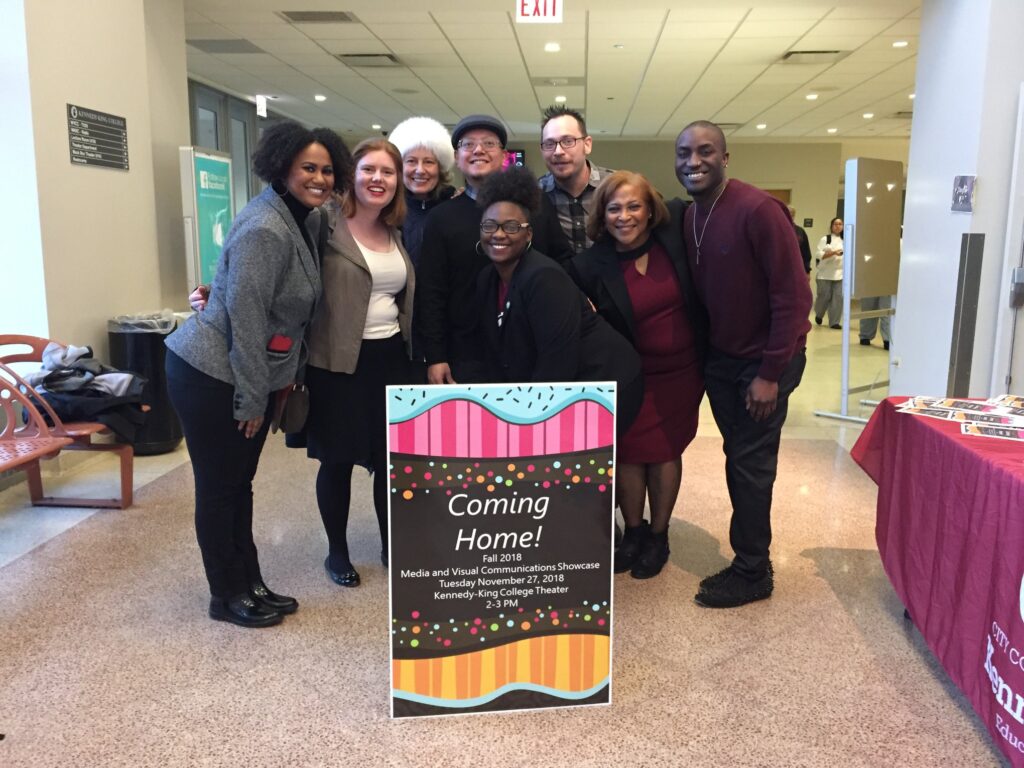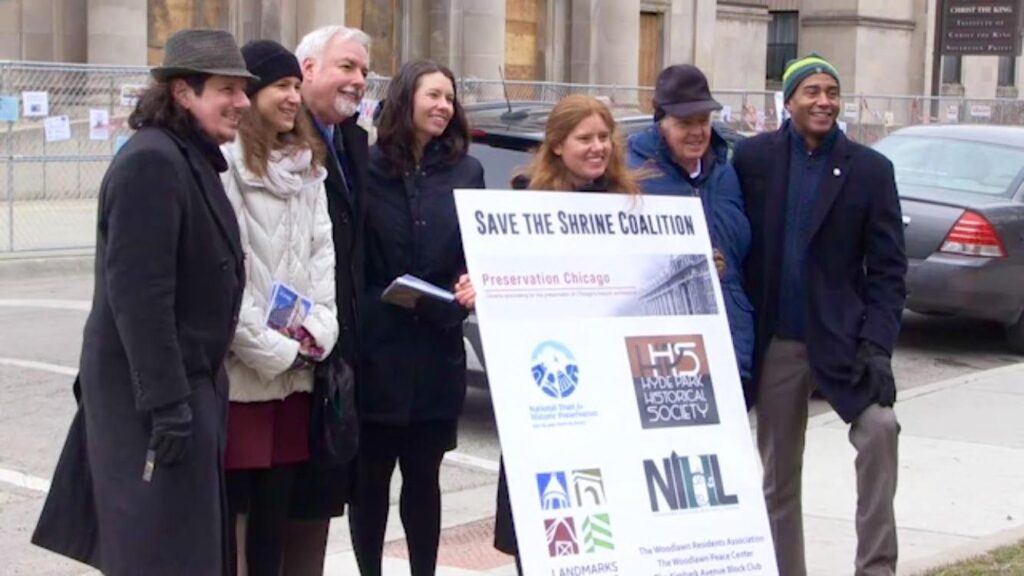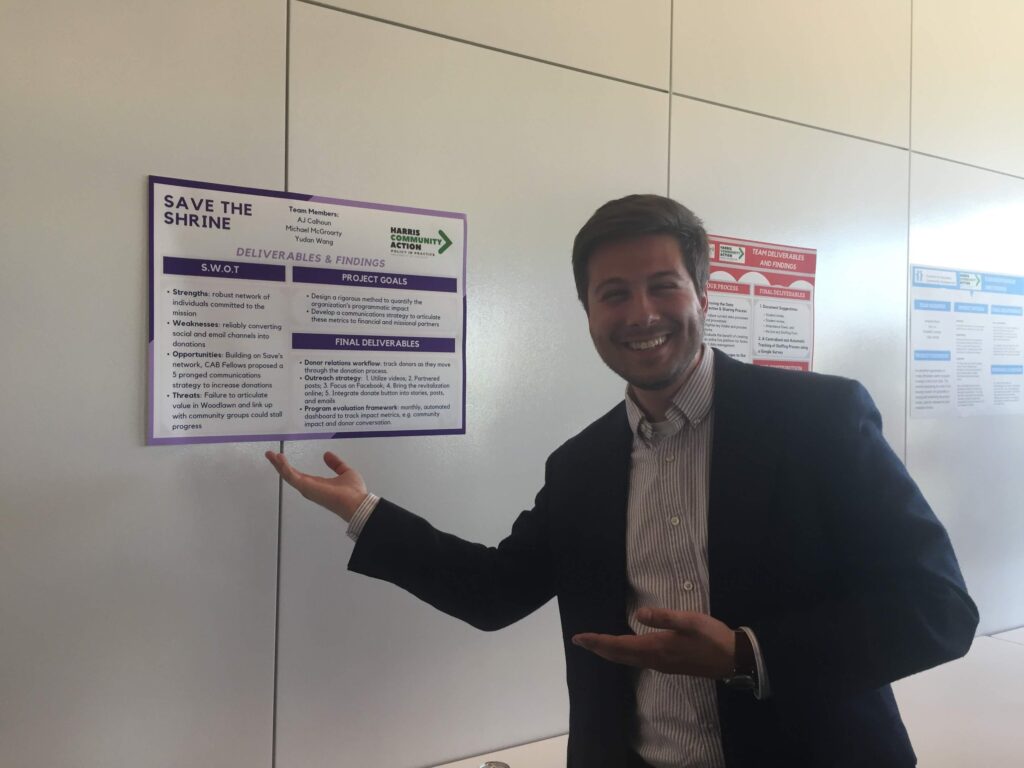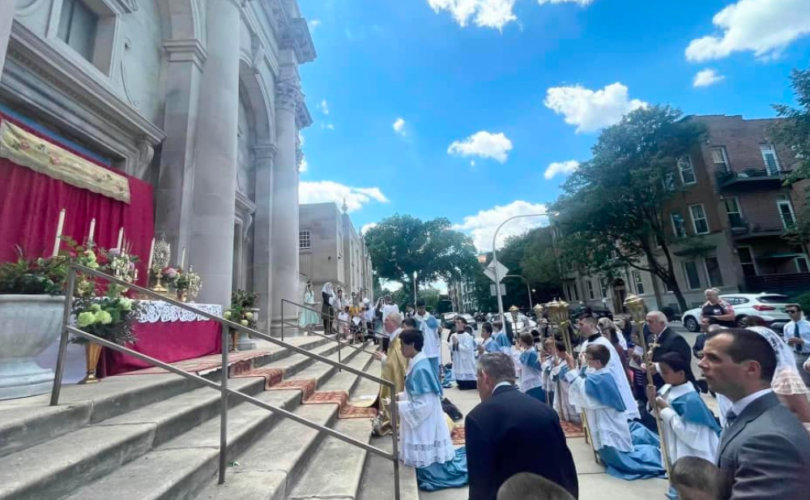
By Judy Carmack Bross

Preservation success stories are rarities and few as down to the wire dangerous as those faced by Emily Nielsen in 2016. Now, in a situation she describes as “confusing, chaotic and with lots of internet speculation,” she is once again matching dramatic challenges with keen strategies and heartfelt determination.


Team Shrine at the Kennedy-King College Fall Showcase! In November 2018 : Left to right: Jennifer Blackman, Emily Nielsen, Laurie Cherbonnier Nielsen, Henry Torres, Jesse Ledbetter, Monique Harvey, Dr. Enid Wells, DeAndre Williams
When we first reported on Emily Nielsen in a 2016 “Women to Watch” column, the fate of her campaign, #SaveTheShrine, was a cliffhanger. The Shrine of Christ the King at 64th and Woodlawn was marked for immediate demolition. Emily along with her co-founder Gabriel Piemonte and about 20 other committed volunteers, backed by professional preservationists, raced the clock to raise $650,000 and obtain 2,250 names on an online petition. The Woodlawn neighborhood made it their project as well and many from diverse religious backgrounds, including those without church affiliation, committed to the cause.
At the time Emily commented:
“We are delighted that the Archdiocese was able to come up with such an innovative solution to save the Shrine. It is now owned by the Institute of Christ the King, the international order of priests who have been serving the Shrine community since 2004. This is the only instance I know of where a diocese has divested itself of a historic church building, while transferring ownership to an entity which will continue to operate it as a place of Catholic worship. This is really a win-win-win for everyone: the faithful, the neighborhood, architecture lovers, and the Archdiocese.”

Emily Nielsen, holding poser, with preservation leaders.
The Shrine of Christ the King church, completed in 1928 as St. Clara Church and Landmarked as St. Gelasius in 2003, is a Chicago Landmark which has been damaged by fires in both 1976 and 2015. Reflecting the Renaissance Revival style with several Baroque elements, the church was designed by ecclesiastical architect Henry J. Schlacks, who later became the founding director of the Notre Dame School of Architecture.

Over the past six years, more than $3 million has been raised to restore the Shrine, with funds coming from parishioners, preservationists and neighbors as well as the National Fund for Sacred Places. Nielsen, who serves as board president of Save the Shrine, led not only fundraising efforts but also the search for Save the Shrine’s Managing Director Jennifer Blackman.
Nielsen addressed the National Trust soon after the victory, the youngest person to have been invited to speak to the organization. What had been a practically around-the-clock effort in 2016 became for all involved a success story. Not only were major preservation groups such as Preservation Chicago, Landmarks Illinois, and the Chicago Field Office of the National Trust critical to the success but also neighborhood groups in Hyde Park, Woodlawn, and Kenwood joined the effort.

The Shrine itself is not restored enough for services to be held there on Sundays, but they were held for years in the gym of adjacent First Presbyterian Church, a great friend throughout the efforts, and more recently in a temporary Chapel in the former parochial school building. The nearby Catholic parish St. Thomas the Apostle in Hyde Park has also generously made their space available to the Shrine’s congregation for holidays and special occasions such as weddings and funerals.
At the time Nielsen said: “It is really a victory for local groups as well. That kind of local solidarity really shows how much the Shrine means to so many people and broadens its base of support so significantly.”
But as all preservationists know, things can change in the blink of an eye.

Once again, all is up for grabs, showing that preservation even in a city such as Chicago where fine leadership in this area abounds, can face grave challenges.
On July 31st, in accordance with an order from the Archdiocese of Chicago, a sign was posted on the Shrine’s chapel door stating, “As of August 1st, the celebration of public Masses is suspended.”
This announcement has implications not only for those who wish to partake in the Latin Mass, but also for Woodlawn area Catholics who now will have to go elsewhere for religious celebration. Suspension of the masses in Woodlawn relates to a recent papal decree limiting the traditional Latin Mass worldwide. St. John Cantius is the only remaining church celebrating this Mass in Chicago at this time.

In 2018, Kennedy-King College students filmed Save the Shrine co-founder Gabriel Piemonte interviewing Shrine Construction Manager Tracey Gillis in the Shrine. Left to right: Jennifer Blackman (Save the Shrine), DeAndre Williams (KKC), Gabriel Piemonte (Save the Shrine), Henry Torres (KKC), Tracey Gillis (Shrine Construction Manager). In the background, Professor of Media Communications Dr. Enid Wells chats with Canon Matthew Weaver of the Institute of Christ the King.

AJ Calhoun, a graduate student at the University of Chicago’s Harris School of Public Policy and a Harris Community Action Fellow, presents the Save the Shrine poster at the conclusion of Save the Shrine’s participation in the Community Programs Accelerator program.
“There is a widespread feeling of betrayal among all the groups who have supported the Shrine’s restoration over the past six years,” Nielsen said. “Members of the First Presbyterian Church next door, which has been so supportive since the start, joined the Shrine’s Canons and faithful in their final procession around the neighborhood on July 31st. The university students who have given so many volunteer hours to the restoration project, both the Media Communications students at Kennedy King College down 63rd St. from the Shrine, and the graduate students from the University of Chicago who have participated through the Harris School of Public Policy’s Harris Community Action program, they have stayed engaged with the Shrine and I see their shock and disbelief in their reactions on social media.”

Nielsen tells us: “I love this one because it shows Kennedy King College students and UChicago students collaborating together on the Shrine project. It was taken in the studio at Kennedy King College. Left to right, back row: Henry Torres (KKC), AJ Calhoun (UChicago), Michael McGroarty (UChicago), Monique Harvey (KKC) and Jesse Ledbetter (KKC). Front row: Emily Nielsen (Save the Shrine), Dr. Enid Wells, Director of the Department of Media Communications, KKC, DeAndre Williams (KKC), Jennifer Blackman (Save the Shrine)
Nielsen feels that the Shrine speaks for itself. “The structure is in such better shape than it was after the fire in 2015, but there are significant funds to be raised,” she said. “As long as the Institute owns the Shrine, we feel that it won’t be demolished, but we want to make sure that the current situation doesn’t erode donors’ trust.”
“The Shrine is a Chicago Landmark and we hope that this designation will be a strong protection,” she said. Nielsen and other members of the Save the Shrine team appeared before the Chicago Landmarks Commission in August and September to tell their story.
“My first goal is to raise awareness of what has happened in order for restoration to continue. When the Archdiocese gave the property to the Institute it was with the understanding that it could function as a church. And this is an understanding that our donors had as well. We feel that across the church spectrum, we have generated goodwill.”

We asked Nielsen to tell us about the role of a preservation activist:
“Landmarks Illinois’ Advocacy Manager, Kendra Parzen, said something that really resonated with me. She said ‘no place is ever saved forever.’ I think that speaks to the Shrine’s situation: its current predicament was utterly unpredictable. And given that, I think the most impactful thing you can do is to try, where you can, to grow and strengthen the network of supporters for buildings like the Shrine, so that when the next unpredictable threat comes, there will be people who care and can take action.”
And what will come next. “As yet we haven’t done some of the things we did in 2016. We haven’t made a film, we have not circulated a petition nor taken out ads or launched major
social media campaigns,” she said. “I have had hopes that we could achieve our goals without an all-out campaign, that the Archdiocese would reverse its course. The Institute is working very well in other cities such as St. Louis, Detroit and Milwaukee.”

A recent comment from a Shine donor echoes Nielsen’s concerns:
“As one of the many contributors to the restoration of the Shrine, I am incredibly disappointed in Cardinal Cupich’s decision. The Shrine is an important part of the Woodlawn community and its congregation is vibrant, diverse and growing. In addition, the Shrine is the only Catholic church in Woodlawn and one of the most beautiful and architecturally significant churches in all of Chicago. I pray that Cardinal Cupich will reconsider his decision soon, so that services can begin again and the important restoration effort can continue..”
For more information about Save the Shrine of Christ the King, visit:







